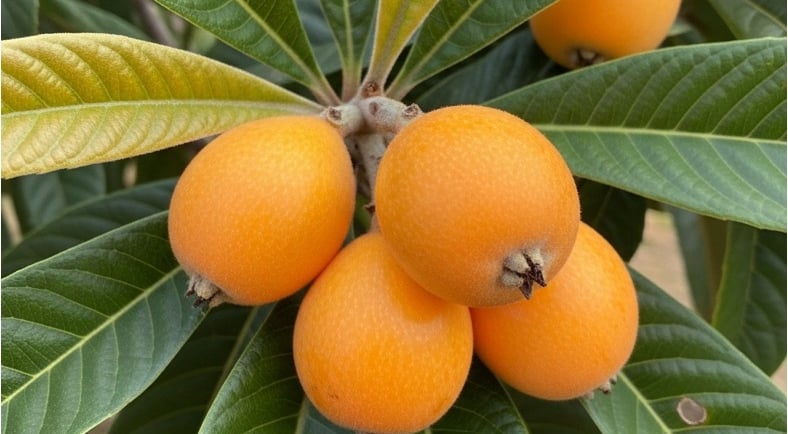🌿 GROWPlantWell – Nurture Nature, Transform Your Space 🌿
🍊 Loquat – The Sweet and Tangy Treasure of the Garden: Health Benefits, Cultivation, and Culinary Uses
Learn all about loquat fruit, its health benefits, how to grow it in different climates, common pests, and tasty ways to enjoy this sweet and tangy fruit.
Grow Plant Well
8/18/20252 min read


🌱 Introduction
The loquat (Eriobotrya japonica) is a small evergreen tree belonging to the rose family (Rosaceae). Originating in China, it has spread worldwide and is now cultivated across Asia, the Mediterranean, the Middle East, the Americas, and beyond.
Admired for its attractive glossy leaves, fragrant white flowers, and clusters of golden-orange fruits, the loquat is both an ornamental and a productive fruit tree. Its sweet-tangy fruit has gained popularity in home gardens and commercial orchards alike.
🍊 Loquat Fruit at a Glance
Taste: Sweet, mildly tangy, reminiscent of apricot and citrus.
Shape: Small, round to pear-shaped fruit.
Colour: Yellow to orange when ripe.
Season: Late winter to early summer, depending on region.
Uses: Fresh eating, jams, chutneys, desserts, syrups, and even wines or liqueurs.
🌿 Growing Loquat Worldwide
Loquat trees are versatile but grow best in subtropical to mild temperate climates.
✅ Planting Requirements
Climate: Mild winters and warm summers; they tolerate light frost but not extreme cold.
Soil: Well-drained, slightly acidic to neutral soils enriched with compost.
Sunlight: Full sun to partial shade.
✅ Care & Maintenance
Watering: Regular watering during flowering and fruiting improves yields.
Fertiliser: Use balanced fertilisers or organic compost twice a year.
Pruning: Light pruning after harvest helps maintain shape and airflow.
Pollination: Many varieties are self-pollinating, but some benefit from cross-pollination for heavier crops.
🌸 Health Benefits of Loquat
Loquats are not only delicious but also a nutritional powerhouse:
Vitamin A & C: Boost immunity and promote healthy skin and vision.
Dietary Fibre: Supports digestion and gut health.
Potassium: Helps regulate blood pressure.
Antioxidants: Reduce oxidative stress and may lower disease risk.
Traditional Medicine: In East Asia, loquat leaves are used in teas and remedies for coughs and inflammation.
🐛 Common Pests and Diseases
Loquats, like other fruit trees, may encounter challenges:
Fruit Fly: A major pest in many regions; control with traps or protective netting.
Birds & Bats: Protect ripening fruit with nets.
Scale Insects & Aphids: Can be managed with horticultural oils or insecticidal soap.
Fire Blight & Leaf Spot: Prevent with pruning, good airflow, and copper-based sprays.
🍯 Delicious Ways to Use Loquat
Loquats are versatile in the kitchen:
Fresh Eating: Peel and enjoy straight from the tree.
Jams & Preserves: Perfect for spreads and baking.
Loquat Chutney: A sweet-sour condiment for curries and meats.
Loquat Syrup or Jelly: Great with pancakes, desserts, or drinks.
Loquat Wine & Liqueur: A traditional delicacy in parts of Asia and the Mediterranean.
🤔 Q&A Section
Q: Can loquat grow in pots or containers?
Yes! Dwarf loquat varieties thrive in large pots if watered and fertilised regularly.
Q: What climates suit loquat best?
Loquat trees grow best in subtropical and Mediterranean regions, but can adapt to temperate climates with mild winters.
Q: Do you need two loquat trees for fruiting?
Most loquat varieties are self-fertile, but cross-pollination can increase fruit size and yield.
🌟 Conclusion
The loquat is a remarkable fruit tree that offers beauty, nutrition, and delicious harvests. From Asia to Europe and the Americas, it has earned a place in gardens and orchards worldwide. Whether you enjoy the fruit fresh, in jams, or as wine, loquats are a golden gift of nature that combine taste, health, and cultural tradition.
If you’re considering adding a versatile fruit tree to your garden, the loquat is a sweet and tangy choice worth planting! 🍊🌿